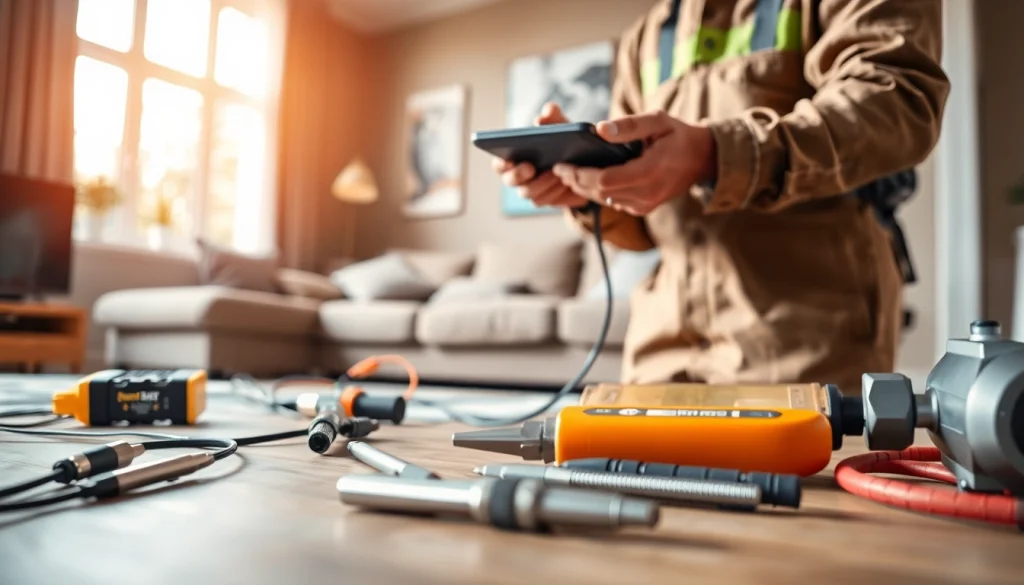What Are EICR Inspections?
Definition and Purpose of EICR Inspections
An Electrical Installation Condition Report (EICR) is a comprehensive assessment of the electrical systems within a property. This structured examination includes a series of tests and inspections aimed at evaluating the safety and efficiency of electrical installations. The primary purpose of an EICR is to identify any defects or dangerous conditions that could pose a risk to users, ensuring that properties adhere to established safety standards.
As electrical installations can deteriorate over time due to various factors such as wear and tear or environmental influences, EICR inspections play a crucial role in maintaining safety. Importantly, they provide property owners with detailed insights into the state of the electrical installations, fostering proactive measures to prevent potential hazards. For more information about these inspections, you can check out EICR Inspections on the RB Testing site.
Why EICR Inspections Are Essential for Property Owners
For property owners, EICR inspections are not just a regulatory requirement; they are vital for ensuring tenant safety and compliance with local laws. Regular inspections help property owners identify issues before they escalate into costly repairs or, worse, accidents. Moreover, having an up-to-date EICR can boost property value by demonstrating to potential buyers or renters that the electrical installations are safe and compliant with safety standards.
Key Components of an EICR Inspection
EICR inspections involve several critical components:
- Visual Inspection: The electrician performs a thorough examination of visible components such as wiring, switches, and outlets.
- Testing: Electrical testing is conducted to assess continuity, insulation resistance, and polarity. This ensures that installations operate correctly and safely.
- Classification of Condition: Each item assessed during the inspection is categorized based on its condition, such as satisfactory or unsatisfactory.
- Report Generation: A detailed EICR report is prepared listing observations and recommendations for any necessary remedial work.
The Legal Requirements Surrounding EICR Inspections
Status of EICR Inspections in Legislative Policies
The legal framework governing EICR inspections varies by region, with several jurisdictions mandating these inspections at specific intervals, especially for rental properties. In many places, it is a legal obligation for landlords to have an EICR conducted every five years. This legislation exists to protect tenants from unsafe electrical conditions and to encourage property maintenance.
Who Requires an EICR Inspection?
EICR inspections are required across various sectors, including:
- Residential Properties: Landlords must ensure their rental properties are safe, with EICRs typically required every five years.
- Commercial Buildings: Businesses are also subject to safety regulations, making EICRs necessary to maintain operational safety and compliance.
- Public Sector Buildings: Schools, hospitals, and other public facilities must meet stringent safety standards, necessitating regular EICR inspections.
Consequences of Neglecting EICR Inspections
Neglecting to conduct EICR inspections can lead to severe consequences, including:
- Legal Repercussions: Landlords and property owners can face hefty fines or legal action for failing to comply with safety regulations.
- Increased Risk of Electrical Fires: Faulty wiring or outdated installations not identified through EICRs can lead to dangerous situations.
- Higher Repair Costs: Issues that are left unchecked may escalate, resulting in higher costs for repair and possible compensation claims.
Preparing for an EICR Inspection
Steps Property Owners Should Take Before an Inspection
Preparation for an EICR inspection involves several proactive steps:
- Organize Access: Ensure that the electrician has unrestricted access to all areas needing inspection, including attics and basements.
- Review Past Reports: Providing the inspector with previous EICR reports can help identify any recurring issues and assist in forming a comprehensive understanding of the property’s history.
- Inform Occupants: If the property is occupied, inform tenants about the inspection schedule to minimize disruptions and prepare for the assessment.
Common Issues to Check Before the Inspection
Before the inspection takes place, there are several common issues property owners can check:
- Test all light fixtures and switches to ensure they are working properly.
- Inspect visible wiring for signs of wear or damage.
- Ensure that circuit breakers are properly labeled and functioning.
Choosing the Right Professional for EICR Inspections
Selecting a qualified electrician for EICR inspections is paramount. Property owners should look for the following credentials:
- Qualifications: Ensure the electrician is registered with a recognized body and has specific qualifications related to EICR inspections.
- Experience: Look for testimonials or reviews indicating the professional’s experience in conducting EICR inspections.
- Insurance: Verify that the electrician holds adequate insurance to protect against potential liabilities during the inspection.
Cost Factors and Financial Implications of EICR Inspections
Average Costs for EICR Inspections
The cost of EICR inspections can vary widely based on factors such as property size, location, and the complexity of the electrical installations. On average, property owners can expect to pay between $150 to $300 for a standard inspection. Larger or more complex properties may incur higher costs, often ranging from $300 to $600.
How EICR Inspections Can Save Money in the Long Run
Investing in regular EICR inspections can lead to significant financial savings in the long run. By identifying potential hazards early, property owners can avoid costly repairs or even catastrophic events like electrical fires. Furthermore, maintaining a safe environment can reduce insurance premiums and liability claims, making EICR inspections a cost-effective strategy for prosperous property management.
Understanding EICR Certificates and Compliance Costs
An EICR certificate documents the findings of the inspection and confirms compliance with safety regulations. The certificate typically includes:
- The overall condition of the installation (satisfactory or unsatisfactory).
- A list of observations that may require attention.
- Recommendations for corrective actions, if necessary.
While there is an associated cost for obtaining EICR certificates, they are invaluable for demonstrating compliance and safeguarding against potential legal issues.
Best Practices for Maintaining Electrical Safety Post-EICR Inspections
Ongoing Maintenance Tips for Property Owners
After an EICR inspection, property owners should implement several best practices to ensure ongoing electrical safety:
- Conduct regular visual inspections of electrical installations.
- Engage qualified electricians for any necessary repairs promptly.
- Maintain records of all inspections, repairs, and upgrades for future reference.
How Often Should EICR Inspections Be Conducted?
The frequency of EICR inspections depends on several factors, including the property type and local regulations. Generally, landlords are advised to conduct inspections every five years. However, properties subjected to heavy use or those with older electrical systems may benefit from more frequent inspections, potentially every three years.
Utilizing EICR Reports for Continuous Electrical Safety
The EICR report serves as a critical reference for property owners. It can be used to track the condition of electrical installations over time, helping to identify trends or recurring issues that may require more significant renovations. Additionally, integrating the recommendations outlined in the report into an ongoing maintenance strategy enhances safety and compliance.





